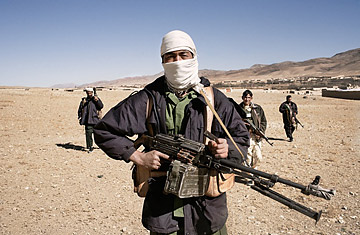
AP3 Members patrol the outskirts of a village. Afghanistan, Wardak province, November 2009
Fifteen months ago, coalition and Afghan forces traveling the road that slices through this rugged mountain valley, less than an hour's drive from the capital Kabul, were attacked so frequently by Taliban gunmen it was nicknamed the "Valley of Death" — one of the country's many. Today, school children walk home on the pavement and apple farmers tend their orchards without fear of firefights. Afghan officials and upbeat residents credit the remarkable turnaround to a U.S.-backed militia program that has armed and trained hundreds of local men to defend what they know best: their own turf.
When the program was launched in Wardak province last February, skeptics argued that state-sanctioned militias were a bad gamble in a country where loyalties can change with the winds. In the absence of a strong state, they warned, there was no guarantee armed groups would not cooperate with the enemy or use their enhanced power to settle old feuds along tribal or ethnic lines. Nevertheless, U.S. military planners believed that ordinary Afghans policing their own communities might be able gain the grassroots support needed to roll back the insurgency that they could not. The idea was partly inspired by the success of the "Sons of Iraq" initiative that, in tandem with a U.S. troop surge, enlisted more than 100,000 Iraqis, including many ex-insurgents, to bring a semblance of peace to that country.
At first glance, members of the so-called Afghan Provincial Protection Force — short of uniforms and armed with no more than Kalashnikov rifles — don't inspire much confidence. Some of the roughly 1,200 members are barely teenagers; others are grandfathers. But their regular foot patrols and presence at a network of new checkpoints have had a stabilizing effect on a strategically important province that is the gateway to Kabul and a critical military supply line. Muhammad Fidai, the governor of Wardak, says they are the "first reason life is safer here. That's not to say everything has been fixed overnight," he adds, "but for sure it's getting better."
The governor should know. The provincial capital of Maidanshahr was a battleground when he took office in July 2008, his home a near-daily target of hostile fire. It took a battalion-sized U.S. operation to clear a path for his first visit to the Jalrez district center, just 10 miles away. That was then. One afternoon this week, he himself drove out incognito to the edge of town in an SUV with a single bodyguard, breathlessly pointing out new construction projects between pauses to make small talk with shopkeepers and militia recruits.
Although the recruits receive just three weeks of training from U.S. Special Forces, before being issued rifles and posted, the militiamen have a distinct advantage. Unlike the Afghan national police, which is widely viewed as predatory, and the Afghan army, whose soldiers are stationed away from their homes often among rival ethnic groups, the militia members are mostly homegrown Pashtuns who are motivated to secure their own communities. Hekmatullah, 18, says he joined not long after a stray bullet wounded his uncle. "We were so sick of the fighting around our homes," he says. According to Army Lt. Col. Matt McFarlane, the top U.S. commander in Wardak province, this also means they enjoy a degree of trust and access to intelligence that outsiders could never achieve. "This is for Afghans, by Afghans, who know their neighbors well," he says.
If any one misbehaves, he will risk the wrath of tribal leaders who have thrown their weight behind the program. Ghulam Muhammad, a former mujahideen commander, is one such supporter. Tall and barrel-chested, with a beard dyed black and red, Muhammad is the last person anyone wants to offend. In the 1980s he fought against the Russians with several thousand men under his command, earning a fearsome reputation that has endured. In a distinctly Afghan twist he later fought with the Taliban and spent time in detention before siding with the Afghan government. Last spring, American officers gave him an ultimatum: work with us or else. Muhammad hesitated and doubts resurfaced about his loyalties but, in the end, he said yes and was chosen to head the program. U.S. officers say his "street cred" has been essential in attracting scores of volunteers and influential elders.
Based on its impact so far, Gov. Fidai says he's eager to expand the militia program, especially into farther-flung districts where militants are able to move more freely. U.S. military commanders have talked of the same, but first want to take more time to ensure that a clear-cut management structure is in place that gives them full oversight of the program and where the money is going. For all the apparent promise in Wardak, Lt. Col. McFarlane said it's important "not to get overly excited" because local Afghan politics are complex and vary dramatically from place to place; what might work well in one district is not guaranteed to succeed elsewhere. Indeed, in northern Kunduz province, militias that were raised to supplement government forces have reportedly devolved into tribal score-settling, with some commanders there now under investigation on criminal charges for looting and rape.
There have been no such complaints yet in Wardak. But there are indications that gains may be reversed if the program remains under-resourced. Ghulam Muhammad claims that more than 200 men have left their posts in frustration over the lack of pay and basic provisions, including at least 20 who are believed to have recently joined the insurgency. Over the past month there has also been a concurrent rise in roadside bombings and attacks on militiamen, testing their resolve. Muhammad worries this pattern will accelerate unless hefty funding is sent immediately to the program. "The government has no choice but to support us," he says, "or the Taliban will be back."
This story was reported with a grant from the Pulitzer Center on Crisis Reporting.
